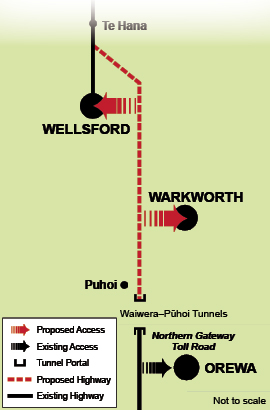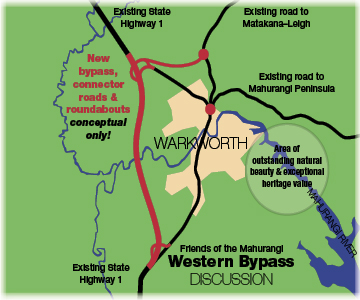Mahurangi Harbour might dodge another bullet

Dodge City: While it’ll make many madder’n hell, including some who wanted to secede the city, others will hope the Mahurangi has dodged a bullet. Schematic NZ Transport Agency [Tunnel’s name: Mahurangi Magazine]
Not dodged, so much as bent down to tie its shoelaces. The second near miss was when newly-hired Rodney County Council town planner John Cameron promptly rescinded the development zone that had been created for the benefit of just one property holder, the Chandris Shipping Line.
The third bullet, the community saw coming and dodged. Plans for a coastal road linking Wenderholm with Mahurangi West had already been overtaken by a waning of enthusiasm for opening up every last corner of the country to the family car. However, a remnant of the scheme had survived in the form of plans to bridge Te Muri to provide parking for two thousand cars behind its beach, to take pressure off Wenderholm. This was only abandoned when an alternative community-initiated concept to develop the bay for walking access only was embraced by the citizen’s advisory group that was then part of the park management plan process.
The Mahurangi West community has been given ample warning of the fourth bullet, and is scrambling to tie its own blindfold.
The NZ Transport Agency is proposing that Mahurangi West and Pūhoi be served by the old state highway only, which would put the nearest motorway access Ōrewa and Warkworth.
This has surprised the Mahurangi West community, which while the only having the toll road trim ten minutes or so off a journey the metropolis, enjoys being spared having to negotiate the Waiwera and Wenderholm hills, which can feel tortuous at the end of a hard day, or night.
But for some, the surprise is a good one. As the motorway’s first coastal destination north of Ōrewa, Mahurangi West was about to be subjected to unprecedented pressure for residential development. However the opening of the tunnels coincided with the global economic downturn, softening the demand for residences for city commuters, and presumably taking a toll of expected revenue.
Mahurangi’s essence is a harbourscape of outstanding natural beauty, a million miles from the metropolis.
For some Mahurangi West residents, being excluded from the Ōrewa to Warkworth stretch of the motorway will be small price to pay for the landscape protection demonstrably not provided by the district plan—the rural look and feel of Mahurangi West Road stands to fare better post the Mahurangi Action Plan, but much has been eroded in recent decades.

Northern Access: Four and a half years ago, frustrated by the lack of discussion the predecessor of the Mahurangi Magazine published this schematic. Sensibly, the NZ Transport Agency is not proposing access from the south. Schematic Mahurangi Bulletin January 2006
The country road proposed by the national transport agency will help strengthen the communities of Mahurangi West and Pūhoi, and also of Ōrewa, Waiwera and Warkworth. Currently, Mahurangi West residents can save money by driving to bulk stores in Albany. But by 2019 when the motorway to Warkworth is projected to open and access to the motorway moved south to Ōrewa, fossil fuel will be taxed too heavily for such excursions to be economic. Driving the electric car to Warkworth, or taking the ferry upriver, will the rational response.
And speaking of Warkworth, the transport agency wants to know what folk think about where the town should be accessed: From the west or the north.
For the love of Warkworth and from self-interest, it has to be hoped that the response from Matakana and Mahurangi East residents and visitors is a resounding, ‘From the north!’ Warkworth retailers will worry about being by-passed, and residents will tend towards the shortest distance, which is from the south. But southern access has been ruled out, despite the extraordinarily extravagant and excruciatingly long-winded four-laning of Auckland Road—not the agency and district council’s most astute move.
The assumptions that underpin the agency’s current highway strategy are patently superseded. The thinking is from some mythical planet that can sustain ten billion souls driving, or being driven, to their hearts’ content. The planet the agency is actually on is already at grave risk of runaway greenhouse effect.
When forced to, in order to clear the hurdles necessary to build its first toll road, the agency embraced tunnelling. This was a huge departure from the cut and fill method it lived and breathed. That small step-change now needs to be followed by a large one: Learn how to design and build wide gauge railways. An efficient rail service between Marsden Point and Auckland would enjoy a natural monopoly against which road transport could not compete.
Not that road transport should be encouraged to compete, it should simply be regulated. The global economic downturn exposed the hubris that de-regulated market forces are next to Godliness. No amount of applied economic dogma green or otherwise can substitute for what is now needed to have a fighting chance to avoid mass species extinctions; only a war footing can do that.
Meantime, a bitter battle will doubtless be mounted against the agency and its plans to deny Mahurangi West direct access to the motorway.
The Mahurangi Magazine votes for the quiet life, a country road, and a zippy electric car.
And prays that being hard-wired to the motorway was a bullet dodged.
